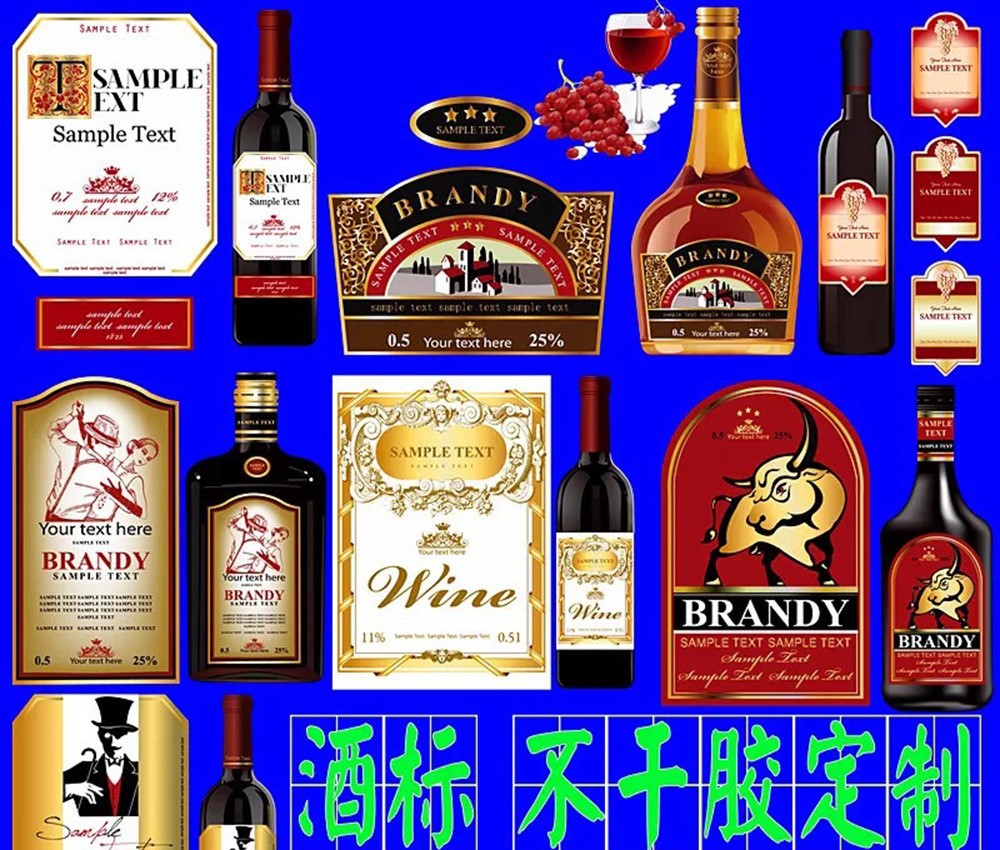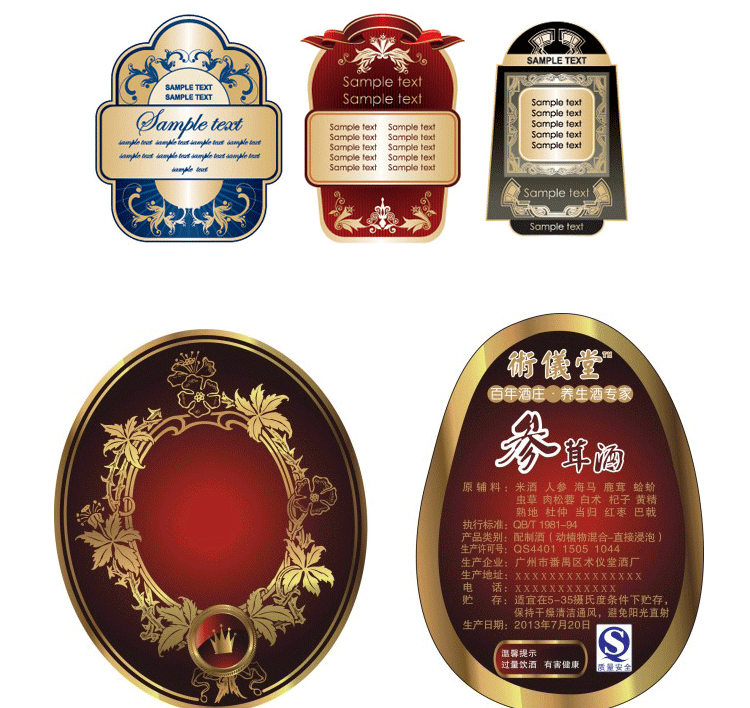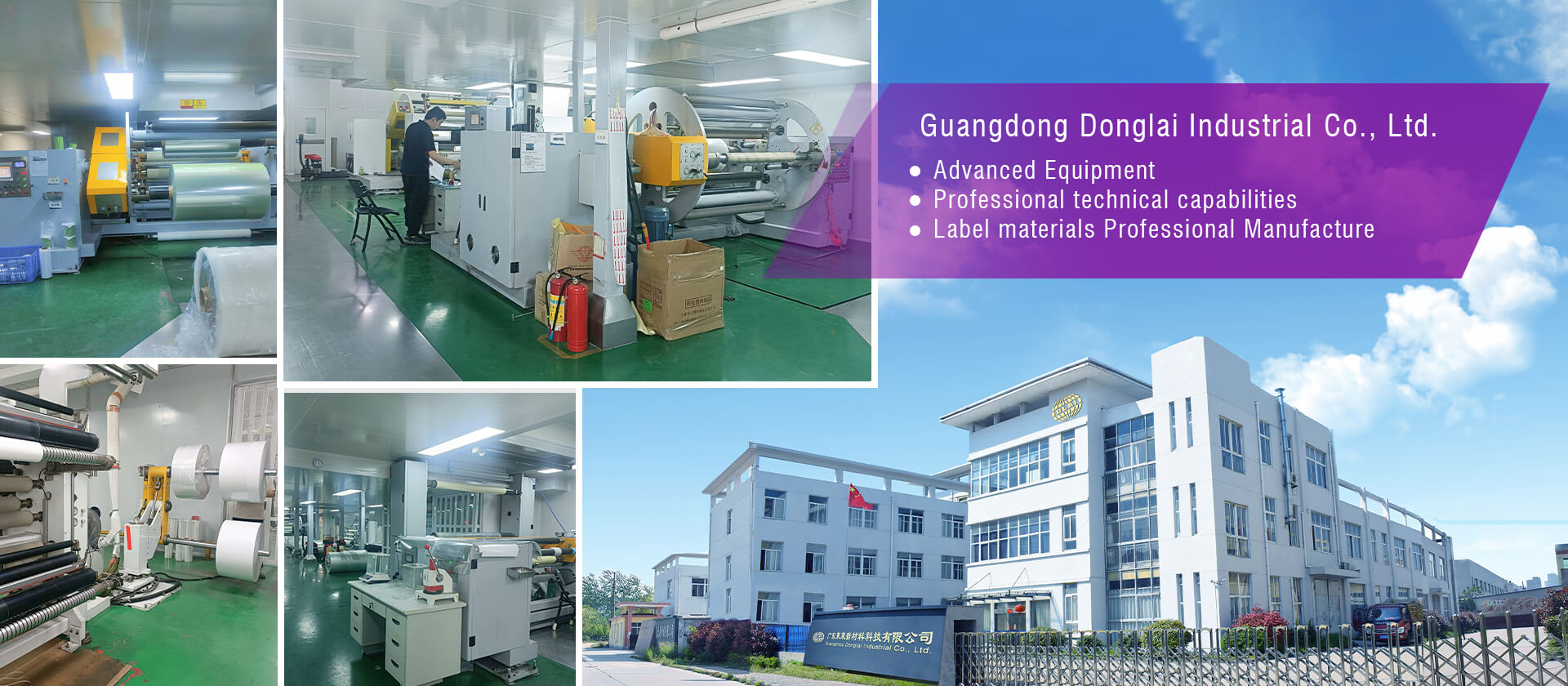As a convenient and practical label form, self-adhesive labels are particularly widely used in alcoholic products. It not only provides product information, but also enhances brand recognition and improves consumers' first impression of the product.
1.1 Functions and applications
Alcohol self-adhesive labels usually perform the following functions:
Product information display: including basic information such as the name of the wine, place of origin, year, alcohol content, etc.
Legal information labeling: such as production license, net content, ingredient list, shelf life and other legally required labeling content.
Brand promotion: Convey brand culture and product features through unique design and color matching.
Visual appeal: Differentiate from other products on the shelf and attract consumers’ attention.
1.2 Design points
When designing alcohol stickers, you need to consider the following points:
Clarity: Ensure that all text information is clearly readable and avoid overly complex designs that make information difficult to decipher.
Color matching: Use colors that are consistent with the brand image, and consider how the colors appear under different lights.
Material selection: According to the positioning and cost budget of the alcoholic product, select the appropriate self-adhesive material to ensure the durability and fit of the label.
Copywriting creativity: The copywriting should be concise and powerful, able to quickly convey the product’s selling points, and at the same time have a certain degree of attraction and memory.
1.3 Market trends
With the development of the market and changes in consumer demand, alcohol self-adhesive labels have shown the following trends:
Personalization: More and more brands are pursuing unique design styles to differentiate themselves from competitors.
Environmental awareness: Use recyclable or biodegradable self-adhesive materials to reduce environmental impact.
Digitalization: Combining QR code and other technologies to provide digital services such as product traceability and authenticity verification.
1.4 Compliance with regulations
Label design for alcoholic products must comply with relevant laws and regulations, including but not limited to:
Food Safety Regulations: Ensure the accuracy and legality of all food-related information.
Advertising Laws: Avoid using exaggerated or misleading language.
Intellectual property protection: Respect other people's trademark rights, copyrights and other intellectual property rights, and avoid infringements.
From the above overview, we can see that alcohol self-adhesive labels are not only a simple information carrier, but also an important bridge for communication between brands and consumers. A successful label design can enhance the brand image and enhance market competitiveness while ensuring the transmission of information.

2. Design elements
2.1 Visual appeal
The design of self-adhesive labels first needs to have strong visual appeal in order to stand out among many products. Elements such as color matching, pattern design, and font selection all have an important impact on visual appeal.
2.2 Copywriting creativity
Copywriting is a key part of conveying information in label design. It needs to be concise, clear and creative, able to quickly grab consumers' attention and convey the core value of the product.
2.3 Brand recognition
Label design should strengthen brand recognition and enhance consumers’ memory of the brand through consistent design of LOGO, brand colors, fonts and other elements.
2.4 Materials and processes
Choosing the right materials and workmanship is critical to the quality and durability of your labels. Different materials and processes can bring different tactile and visual effects.
2.5 Functionality and practicality
In addition to being beautiful, labels should also have certain functionality, such as anti-counterfeiting markings, traceability information, use of environmentally friendly materials, etc., to meet the needs of the market and consumers.
2.6 Legal Compliance
When designing self-adhesive labels, you need to ensure that all copywriting, patterns, and brand elements comply with relevant laws and regulations to avoid legal risks such as infringement.
3. Material selection
In the production process of alcohol self-adhesive labels, the choice of material has a crucial impact on the texture, durability and overall appearance of the label. The following are several materials commonly used for wine labels, as well as their characteristics and applicable scenarios:
3.1 Coated paper
Coated paper is a commonly used wine label paper and is favored for its high printing color reproduction and relatively low price. Depending on the surface treatment, coated paper can be divided into two types: matte and glossy, which are suitable for wine label designs that require different gloss effects.
3.2 Special paper
Specialty papers such as Jiji Yabai, ice bucket paper, Ganggu paper, etc. are often used for labels of high-end alcoholic products because of their unique texture and texture. These papers not only provide an elegant visual effect, but also demonstrate good durability in certain environments, such as ice bucket paper that remains intact when red wine is soaked in an ice bucket.
3.3 PVC material
PVC material has gradually become a new choice for wine label materials due to its water resistance and chemical resistance. PVC labels can still maintain good stickiness and appearance in humid or watery environments, and are suitable for outdoor use or product packaging that requires frequent cleaning.
3.4 Metal material
Labels made of metal, such as gold, silver, platinum paper or metal plates, are often used for high-end or special-themed alcoholic products due to their unique luster and texture. Metal stickers can provide a unique high-end feel, but the cost is relatively high.
3.5 Pearlescent paper
Pearlescent paper, with its pearlescent effect on the surface, can add a bright luster to wine labels and is suitable for products that need to attract attention. Pearlescent paper is available in a variety of colors and textures to meet different design needs.
3.6 Environmentally friendly paper
As a sustainable choice, environmentally friendly paper is increasingly favored by alcohol brands. It not only embodies the brand's environmental protection concept, but also meets diverse design needs in terms of texture and color.
3.7 Other materials
In addition to the above materials, other materials such as leather and synthetic paper are also used in the production of wine labels. These materials can provide unique tactile and visual effects, but may require special processing techniques and higher costs.
Choosing the right material can not only enhance the external image of alcoholic products, but also show better performance in actual use. When selecting materials, it is necessary to comprehensively consider cost, design requirements, use environment, and the feasibility of the production process.

4. Customization process
4.1 Requirements analysis
Before customizing alcohol self-adhesive labels, you first need to conduct a needs analysis to understand the specific needs of customers. This includes the size, shape, material, design elements, information content, etc. of the label. Requirements analysis is the first step in the customization process, ensuring that subsequent design and production can meet customer expectations.
4.2 Design and production
Based on the results of demand analysis, designers will carry out creative designs, including combinations of patterns, text, colors and other elements. During the design process, designers need to consider brand image, product features, and target consumer preferences. After the design is completed, we will communicate with the customer and make adjustments based on feedback until the design draft is finally confirmed.
4.3 Material selection
The choice of label material is critical to the quality of the final product. Commonly used self-adhesive materials include PVC, PET, white tissue paper, etc. Each material has its own specific characteristics and applicable scenarios. Factors such as durability, water resistance, adhesion, etc. need to be considered when choosing.
4.4 Printing process
The printing process is a key link in label production, involving aspects such as color reproduction and image clarity. Modern printing technologies such as screen printing, flexographic printing, digital printing, etc. can select the appropriate printing process according to design requirements and production volume.
4.5 Quality inspection
In the label production process, quality inspection is an indispensable link. The printing quality, color accuracy, material quality, etc. of the labels need to be strictly inspected to ensure that each label meets the standards.
4.6 Die cutting and packaging
Die cutting is to accurately cut the label according to the shape of the design draft to ensure that the edges of the label are neat and free of burrs. Packaging is to protect labels from damage during transportation, usually in rolls or sheets.
4.7 Delivery and Application
After completing the above steps, the label will be delivered to the customer. When customers apply labels to wine bottles, they need to consider the adhesion and weather resistance of the labels to ensure that they can maintain good display effects in different environments.
5. Application scenarios
5.1 Diverse applications of wine labels
Wine self-adhesive labels show their diversity and personalization on different wine products. From red and white wine to beer and cider, each product has its own specific label design needs.
Red wine labels: Usually made of high-quality materials, such as mirror coated paper or art paper, to show the elegance and quality of the red wine.
Liquor labels: You may prefer to use simple, traditional designs, such as kraft paper stickers, to convey the characteristics of its long history and traditional craftsmanship.
Beer labels: Designs tend to be more lively, using bright colors and patterns to appeal to a younger consumer base.
5.2 Selection of label materials
Different wine types have different requirements for the selection of label materials. These requirements are usually related to the storage conditions of the wine and the target market.
Anti-ice bucket art paper: suitable for wines that need to taste better after being chilled, and can maintain the integrity and beauty of the label in low temperature environments.
Waterproof and oil-proof material: Suitable for environments such as bars and restaurants, ensuring labels remain legible despite frequent contact with water and oil.
5.3 Copywriting creativity and cultural expression
The copywriting of alcohol self-adhesive labels must not only convey product information, but also carry brand culture and stories to attract consumers' attention.
Integration of cultural elements: Incorporate regional characteristics, historical stories or brand concepts into the design, making the label a carrier for brand cultural communication.
Creative visual presentation: Use the clever combination of graphics, colors and fonts to create a unique visual impact and enhance the appeal of the product on the shelf.
5.4 Combination of technology and craftsmanship
The development of modern printing technology has provided more possibilities for alcohol self-adhesive labels. Combining different processes can greatly improve the texture and functionality of labels.
Hot stamping and silver foil technology: Adds a sense of luxury to the label and is often used in label design for high-end wines.
UV printing technology: Provides high gloss and color saturation, making labels more dazzling under light.
Laminating process: protects labels from scratches and contamination, extending label life.
6. Market trends
6.1 Market demand analysis
As an important part of product identification, the market demand for alcohol self-adhesive labels has increased steadily with the growth of the alcohol industry. According to the "Research Report on Development Strategic Planning and Investment Direction of China's Self-Adhesive Label Industry from 2024 to 2030", the market size of China's self-adhesive label industry has grown from 16.822 billion yuan in 2017 to 31.881 billion yuan in 2023. Demand It increased from 5.51 billion square meters in 2017 to 9.28 billion square meters. This growing trend shows that self-adhesive labels are increasingly used in alcohol packaging.
6.2 Consumer preferences and behavior
Consumers are paying more and more attention to brand and packaging design when choosing alcoholic products. As a key element to enhance product appearance and convey brand information, self-adhesive labels have a direct impact on consumers' purchasing decisions. Modern consumers prefer label designs that are creative, personalized and environmentally friendly, which prompts alcohol companies to invest more energy and cost in label design.
6.3 Technology and innovation trends
Advances in printing technology and materials science have significantly increased the customization and functionality of self-adhesive labels. For example, smart tags integrated with RFID chips can realize remote identification and information reading of items, improving supply chain management efficiency. In addition, the application of environmentally friendly materials, such as renewable paper and bio-based adhesives, makes self-adhesive labels more in line with green packaging requirements.
6.4 Industry competition and concentration
China's self-adhesive label industry has a relatively low concentration level, and there are many companies and brands in the market. Large manufacturers occupy market share through advantages such as scale advantages, brand influence, and advanced technology, while small and medium-sized enterprises compete with large manufacturers through strategies such as flexible production methods and diversified products and services. In the future, with the continuous advancement of technology and the increasing market demand for high-quality labels, industry concentration is expected to gradually increase.

Contact us now!
Over the past three decades, Donglai has achieved remarkable progress and emerged as a leader in the industry. The company's extensive product portfolio comprises four series of self-adhesive label materials and daily adhesive products, encompassing more than 200 diverse varieties.
With an annual production and sales volume exceeding 80,000 tons, the company has consistently demonstrated its capability to meet the market demands on a large scale.
Feel free to contact us anytime! We're here to help and would love to hear from you.
Adress: 101, No.6, Limin Street, Dalong Village, Shiji Town, Panyu District, Guangzhou
Phone: +8613600322525
mail: cherry2525@vip.163.com
Sales Executive
Post time: Aug-12-2024

